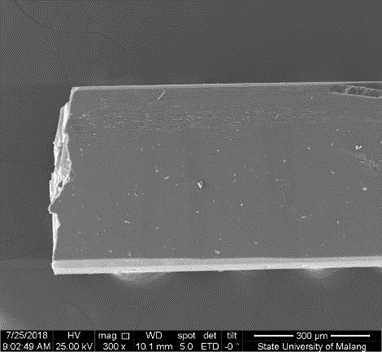Synthesis and Characterization of Complex Compounds of Cadmium (II) Nitrate, Potassium Thiocyanate, and 2,2-Bipyridine Ligand
DOI:
https://doi.org/10.59535/faase.v1i2.181Keywords:
Cadmium (II), Potassium Thiocyanate, Ligands 2,2’-bipyAbstract
A complex compound of a central atom of cadmium(II), potassium thiocyanate, and a 2,2'-bipy ligand with a stoichiometric ratio of 1:2:2 has never been reported. The aim of this research is to determine the coordination pattern of the 2,2'-bipy ligand and thiocyanate ion and the stability of the compounds formed. Synthesis of complex compounds was carried out using the direct reaction method, characterization of the complex compounds produced using the melting point test, FTIR analysis, SEM-EDX analysis, DHL test, thiocyanate ion qualitative test, and Gaussian 09W analysis. This synthesis produces a block-shaped colorless complex compound with a melting point of 159-161°C and has a distorted tetrahedral geometry around the central cadmium(II) atom and a free energy of -740 kJ/mol and a free energy per bond of -25 kJ/ mol.
Downloads
References
N. Arunadevi et al., ‘Synthesis and crystal growth of cadmium naphthoate crystal for second order non-linear optics and cytotoxic activity’, Journal of Dispersion Science and Technology, vol. 43, no. 14, pp. 2192–2208, Nov. 2022, doi: 10.1080/01932691.2021.1925559.
H.-M. Park et al., ‘Anion Effects on Crystal Structures of CdII Complexes Containing 2,2’-Bipyridine: Photoluminescence and Catalytic Reactivity’, Bulletin of the Korean Chemical Society, vol. 33, no. 5, pp. 1517–1522, 2012, doi: 10.5012/bkcs.2012.33.5.1517.
L. Fan et al., ‘Two cadmium(II) coordination polymers as multi-functional luminescent sensors for the detection of Cr(VI) anions, dichloronitroaniline pesticide, and nitrofuran antibiotic in aqueous media’, Spectrochimica Acta Part A: Molecular and Biomolecular Spectroscopy, vol. 239, p. 118467, Oct. 2020, doi: 10.1016/j.saa.2020.118467.
V. Amani, R. Alizadeh, H. S. Alavije, S. F. Heydari, and M. Abafat, ‘Mononuclear mercury(II) complexes containing bipyridine derivatives and thiocyanate ligands: Synthesis, characterization, crystal structure determination, and luminescent properties’, Journal of Molecular Structure, vol. 1142, pp. 92–101, Aug. 2017, doi: 10.1016/j.molstruc.2017.04.034.
X.-Q. Zhang, Q. Yu, H.-D. Bian, X.-G. Bao, and H. Liang, ‘Synthesis, structures, and characterization of cadmium(II), cobalt(II), and copper(II) metal polymers with tetrazole-1-acetate’, Journal of Coordination Chemistry, vol. 62, no. 13, pp. 2108–2117, Jul. 2009, doi: 10.1080/00958970902783568.
G. A. Bowmaker, Y. Kim, B. W. Skelton, A. N. Sobolev, and A. H. White, ‘Structures of 1 : 1 Mononuclear Adducts of Zinc(ii) Halides, ZnX2 (X = Cl, Br, I) and of New Hydrates of 1 : 1 Adducts of Zinc(ii) Nitrate and Sulfate with Aromatic N,N′′-Bidentate Base Derivatives of Pyridine (bpy, phen)’, Aust. J. Chem., vol. 73, no. 6, pp. 511–519, Nov. 2019, doi: 10.1071/CH19365.
L. Zeybel and D. A. Köse, ‘Acesulfame complex compounds of some lanthanide group metal cations. Synthesis and characterization’, Journal of Molecular Structure, vol. 1226, p. 129399, Feb. 2021, doi: 10.1016/j.molstruc.2020.129399.
D. Singha, S. C. Halder, A. D. Jana, and N. Pal, ‘The coordination chemistry and supramolecular interactions of 2-(2′-Pyridyl)imidazole ligand: a comprehensive review with theoretical insight’, Reviews in Inorganic Chemistry, Aug. 2023, doi: 10.1515/revic-2023-0016.
I. A. H. A. Sherwani, A. Köse, Ö. Güngör, H. Kırpık, S. A. Güngör, and M. Köse, ‘Synthesis, characterization and investigation of photophysical and biological properties of Cu(II) and Zn(II) complexes of benzimidazole ligands’, Applied Organometallic Chemistry, vol. 36, no. 4, p. e6585, 2022, doi: 10.1002/aoc.6585.
D. Avcı et al., ‘Synthesis, DFT calculations and molecular docking study of mixed ligand metal complexes containing 4,4′-dimethyl-2,2′-bipyridyl as α-glucosidase inhibitors’, Journal of Molecular Structure, vol. 1205, p. 127655, Apr. 2020, doi: 10.1016/j.molstruc.2019.127655.
B. Notash, N. Safari, A. Abedi, V. Amani, and H. R. Khavasi, ‘Cadmium(II) complexes containing 2,2′-dimethyl-4,4′-bithiazole ligand: synthesis, characterization, and crystal structure’, Journal of Coordination Chemistry, vol. 62, no. 10, pp. 1638–1649, May 2009, doi: 10.1080/00958970802672978.
I. Khaled, R. B. Ahmed, I. Saidi, R. Abbassi, M. O. Abdelkader, and A. H. Harrath, ‘Salicyclic acid against the disruptive effects of cadmium induces oxidative stress and biochemical and histopathological changes in the ovary of the freshwater leech Limnatis nilotica (Savigny, 1822)’, Environmental Pollutants and Bioavailability, vol. 34, no. 1, pp. 321–330, 2022.
S. Hajari, H. Keypour, M. T. Rezaei, S. H. M. Farida, and R. W. Gable, ‘New 15-membered macrocyclic Schiff base ligand; synthesis some Cd(II), Mn(II) and Zn(II) complexes, crystal structure, cytotoxicity, antibacterial and antioxidant activity’, Journal of Molecular Structure, vol. 1251, p. 132049, Mar. 2022, doi: 10.1016/j.molstruc.2021.132049.
M. A. Shmelev et al., ‘Cadmium-Inspired Self-Polymerization of {LnIIICd2} Units: Structure, Magnetic and Photoluminescent Properties of Novel Trimethylacetate 1D-Polymers (Ln = Sm, Eu, Tb, Dy, Ho, Er, Yb)’, Molecules, vol. 26, no. 14, Art. no. 14, Jan. 2021, doi: 10.3390/molecules26144296.
B. A. Ismail, Z. H. Abd El-Wahab, O. A. M. Ali, and D. A. Nassar, ‘Synthesis, structural characterization, and antimicrobial evaluation of new mononuclear mixed ligand complexes based on furfural-type imine ligand, and 2,2′-bipyridine’, Sci Rep, vol. 13, no. 1, Art. no. 1, Jun. 2023, doi: 10.1038/s41598-023-36060-0.

Downloads
Published
How to Cite
Issue
Section
License
Copyright (c) 2023 Khoirul Faqih, Rong Cao, Antonio Zucca, Muntholib Muntholib

This work is licensed under a Creative Commons Attribution 4.0 International License.
By submitting a manuscript to Frontier Advances in Applied Science and Engineering (FAASE), the author(s) agree to the following terms:
-
Copyright: The author(s) retain copyright to their work, granting Frontier Advances in Applied Science and Engineering (FAASE) the right to publish it. Articles are licensed under a Creative Commons Attribution 4.0 International License (CC BY).
-
License Grant: The CC BY license allows others to share and adapt the work for any purpose, even commercially, provided proper attribution is given to the original author(s) and the source, a link to the Creative Commons license is provided, and any changes made are indicated.
-
Author's Rights: Authors are allowed to enter into separate, additional contractual arrangements for the non-exclusive distribution of the journal's published version of the work, with proper acknowledgment of its initial publication in Frontier Advances in Applied Science and Engineering (FAASE).
-
Permissions: Reproduction, posting, transmission, or other distribution or use of the final published article, in whole or in part, requires prior written permission from Frontier Advances in Applied Science and Engineering (FAASE) and the respective author(s).
-
Attribution: Proper attribution must be given to the original author(s) and the source, indicating that the work was originally published in Frontier Advances in Applied Science and Engineering (FAASE) with a link to the published article.
-
No Warranty: The journal and its editorial team make no representations or warranties regarding the accuracy, completeness, or fitness for a particular purpose of the published work.
-
Dispute Resolution: Any disputes arising from the use of the licensed material shall be governed by the laws of [Jurisdiction] without regard to conflicts of law principles.
By submitting a manuscript to FAASE, the author(s) agree to abide by these license terms and grant the necessary rights to Frontier Advances in Applied Science and Engineering (FAASE) for the publication and dissemination of the submitted work.
Most read articles by the same author(s)
- Khoirul Faqih, Rong Cao, Saeed Ahmad, Screening of Flavonoid Derivatives as Candidate Inhibitors For nsP2 Protease of Chikungunya Virus Using Molecular Docking , Frontier Advances in Applied Science and Engineering: Vol. 2 No. 1 (2024)










